Making Microtonal Music is Easier Than You’d Think, Part 2
(This is part 2. For part 1 go here. And before editing this article, please read the page at this link.)
Article by Michael W. Dean...(SyntheticThought)
...OK, here's some of the maths revealed in Scala on one of the 5374 tuning files included with my VSTs (Bohlen-Pierce with two tones altered by minor BP diesis, slightly more equal):
(BEGIN SCARY MATHS):
0: 1/1 0.000000 unison, perfect prime
1: 49/45 147.428097 BP minor semitone
2: 25/21 301.846520 BP second, quasi-equal minor third
3: 9/7 435.084095 septimal major third, BP third
4: 7/5 582.512193 septimal or Huygens' tritone, BP fourth
5: 75/49 736.930616 BP fifth
6: 5/3 884.358713 major sixth, BP sixth
7: 9/5 1017.596288 just minor seventh, BP seventh
8: 49/25 1165.024385 BP eighth
9: 15/7 1319.442808 septimal minor ninth, BP ninth
10: 7/3 1466.870906 minimal tenth, BP tenth
11: 63/25 1600.108480 quasi-equal major tenth, BP eleventh
12: 135/49 1754.526904
13: 3/1 1901.955001 perfect 12th
Number of notes : 13
-- Interval properties --
Smallest interval : 27/25, 133.2376 cents, class 1
Average step (divided formal octave): 146.3042 cents
Largest one step interval : 375/343, 154.4184 cents
Average / Smallest step : 1.098070
Largest / Average step : 1.055461
Largest / Smallest step : 1.158971
Median interval of one step : 49/45, 147.4281 cents, amount: 6
Most common interval of one step : 49/45, 147.4281 cents, amount: 6
Least squares average step : 146.20906 cents, oct.: 1900.71781 cents
Scale is strictly proper
Interval pattern alph. order: ABCABACABACBA
Interval pattern size order : MLSMLMSMLMSLM
Scale is a Constant Structure, by a margin of 112.05673 cents
Scale diversity : 0.283864
Rothenberg stability : 1.000000 = 1
Lumma stability : 0.866364
Number of different interval sizes : 38 = 3.16667 / class
Number of one step interval sizes : 3
Highest interval variety : 4
Mean interval variety : 3.16667 = 19/6
Median interval variety : 3
Lowest interval variety : 3
Smallest interval difference : 16875/16807, 6.9903 cents
Most common intervals : 7/5, 582.5122 cents & inv., amount: 10
Most common triad is 0.0 582.512 1319.443 cents, amount: 7
Number of recognisable fifths : 2, average 715.7498 cents
Number of appreciable fifths : 0
Number of recognisable fourths : 0
Best fifths form a closed circle
Best major thirds form a closed circle
Best minor thirds form a closed circle
Formal octave complements present : 13 = 100.0000%
2/1 octave complements present : 0 = 0.0000%
Limited transpositions with margin 21.1808 cents:
1 2 3 4 5 6 7 8 9 10 11 12
Limited inverse transpositions with margin 21.1808 cents:
1 2 3 4 5 6 7 8 9 10 11 12
Inversional symmetry on degrees :0
Inversional symmetry on intervals :6-7
-- Rational properties --
Prime limit : 7
Odd number limit : 6075 (O: 6075 U: 2401)
Highest odd numerator or denominator: 135
Scale harmonicity : 0.012488
Average absolute harmonicity : 0.078049
Specific harmonicity : 0.072166
Fundamental : 1/11025, -13.4285 octaves, 0.0237 Hz.
Guide tone : 33075, 15.0135 octaves, 8653265.572 Hz.
Exponens Consonantiae : 3.646519E+08, 28.44194 octaves
Euler's gradus suavitatis : 51
Sum of Mann's harmonic distance : 348.0, average 26.76923
Mersenne's string divisions : too high to compute
Sum of van Prooijen's expressibility: 16.53393, average 1.27184
Sum of Tenney's harmonic distance : 29.72801, average 2.28677
Vogel's harmonic complexity : 31.61538
Wille's k value : 16537
Wilson's harmonic complexity : 63
Rectangular lattice diameter : 13
Triangular lattice diameter : 7
Lattice compactness : 278.65409, average 3.06213
Lattice compactness (without 2's) : 278.65409, average 3.06213
Number of different primes : 3
Prime exponents' range, average, count, tones@limit:
3: -2 .. 3 0.53846 17 1
5: -2 .. 2 0.00000 14 2
7: -2 .. 2 0.00000 14 10
Average exponent except 2's : 7 / 13 = 0.53846
Average absolute exponent except 2's: 45 / 13 = 3.46154
Scale is JI-epimorphic in non-monotonic order: <13 17 24|
Scale is JI-epimorphic: <13 19 23| = standard
Scale is JI-epimorphic in non-monotonic order: <13 20 25|
Scale is JI-epimorphic in non-monotonic order: <13 21 22|
Scale is JI-epimorphic in non-monotonic order: <13 21 23|
(END SCARY MATHS.)
If you want a simple non-scary into to the maths of xen, check out this video.
METHOD 3: MICROTONAL TUNINGS IN KONTAKT (and even a little bit in Reaktor)
Kontakt is a very robust sampler, that has a bunch of very real sounding instrument samples. You can basically play a whole orchestra or rock band or most well known classic synths in it. And I really doubt more than about ' of 1% of people could tell the difference. And any who could tell would likely tell based on the playing style rather than the sound.
You can also import any sound into Kontakt and play it on a keyboard. A lot of software can do this, but Kontakt is very tweakable with what you do with the sound. There are also a lot of tutorials online for most anything.
(Thank you Chris Vaisvil for this trick. I've just simplified his instructions, and made them easier to find.)
With this technique, you can't import tuning files. But you can play any instrument that comes with Kontakt in any equal temperament tuning. You can also do that with any sound you import, including human voice samples. I do that a lot lately.
First, open Kontakt and pick an instrument.
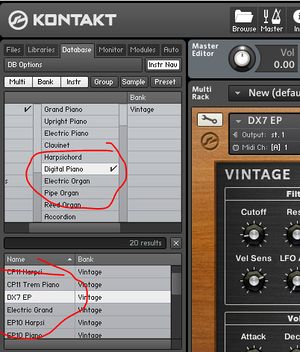
NOTE: Kontakt is a stand-alone program, but some people don't know that is also comes with a VST version, that will work inside your DAW. Here's a video tutorial I made on that a while back.
It's for an old version of Cubase, but these instructions should work in any DAW if you can't figure it out on your own. Note that some of the comments on that video are people saying they didn't know it could be used as a VST.
Then click on the little wrench (or spanner if you're in the UK) and the click on Script Editor:
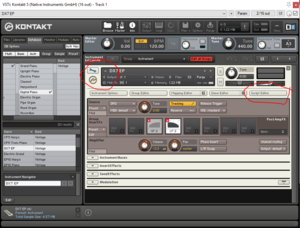
Now go to Preset / Factory / Tuning / Notes Per Octave
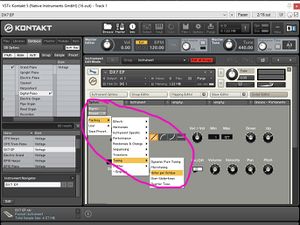
Finally, set the number of notes you want per octave. Here I've set it to 53 notes per octave. This will produce the tuning system of 53 TET (53 edo).
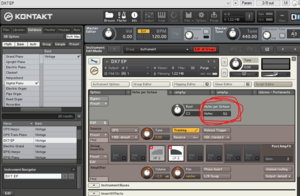
You can set it to anything between 2 edo, and 1200 edo. Though no human could discern adjacent notes at 1200. Most people can't do it at much more than about 53 edo. I can discern them at 120 edo, and I have a song that's partially in 120 TET.
Then hit the wrench icon to go back to the instrument controls, and start playing.
When you go to close the instrument (or close Kontakt) you will be prompted to save the instrument. If you save it, it will be in that tuning when you re-open it.
You should do this if you're putting it onto a project in your DAW.
TIP: when you first start with microtonal music, I recommend using TETs / EDOs less than 12. Pretty much anything sounds good in 5 edo, 7 TET, 8 TET, 9 edo, etc.
MICROTONAL TUNINGS IN REAKTOR
It's not as easy to do non-12 TET equal temperament in Native Instruments' other flagship synth product, Reaktor. Reaktor is a graphical modular software music studio, that comes with a bunch of pre-built synths and samplers, but also allows users to build and share new instruments.
The only Reaktor microtonal synth I've found is this re-mix of the default Reaktor synth, SoundForum, with microtonal capabilities added. The direct download is hard to find in that article, the zip download is here.
SoundForum, in this iteration, has an additional knob added to pick the number of notes per octave:
If anyone who is good at remixing Reaktor ensembles wants to isolate that module, and make a new module that will modify any other module in Reaktor, let me know and I'll add it here. I make my synths in SynthEdit.
Also check out Reaktor Microtuner, a free block for Reaktor to re-tune any instrument in Reaktor. Requires Reaktor 6.1.1, (R35), or later:
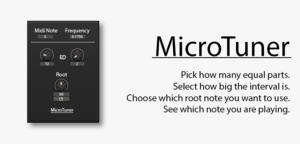
For info on using Blocks in Reaktor, check out this video.
Finally, I would be remiss in the soft synth list if I did not mention this Microtonal Rhodes piano VST: EP-MK1:
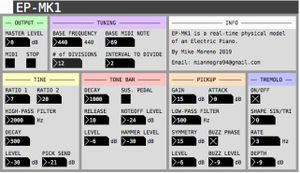
It works for Linux, Windows and Mac. (Files for all are in the same download zip).
The EP-MK1 only has one sound (electric piano), but does it well. Is a little muddy (so are actual physical Rhodes electric pianos!), but sounds great if you add a gentle high-end boost before a little bit of reverb.
It cannot import tuning files, but can play any EDO or even ED-non octave. And can do something few microtonal VSTs can do: it can play non-integer EDOs (!). Try entering something like
15.7
into the
# of DIVISIONS
field and hit Enter.
METHOD 4 - REMOVING THE FRETS ON A GUITAR AND PLAYING IT FRETLESS
I recommend doing this first on a cheap guitar. I used a Fender Squire that cost 150 bucks on Amazon. And I don't recommend doing it on a Gibson. The binding on the sides of the fretboard will make this much harder to do, and you'll risk messing up the guitar. Fenders or Fender types are best.
You can also just buy a Fender-type neck and use that, and then bolt on to an existing guitar to try this out. Here's one (without machine heads) for about 75 dollars. And here is one for about 50 dollars. Fender machine heads are available here.
De-Fret me baby, all night long!
--Wood filler. I use this. It's light color, so where the frets were will stand out on the dark neck, to make it easier to play fretless.
--Phillips head screwdriver
--Soldering iron
--Needle-nose pliers
--Fine sandpaper
--Plastic or wooden putty knife, or a metal kitchen butter knife
If you want dark wood filler, use this.
Start by removing the strings from the guitar.
Then unscrew the neck from the back. Do one screw, then another, going all the way round until the neck comes off. There may be a tiny bit of glue in there, you can just break the glue, there isn't much, so it shouldn't splinter the wood.

Next, heat up one of the frets with a soldering iron to melt the glue under frets. You will want to do this in a ventilated area, maybe even outside, and/or wear a good mask. Because it does produce a bit of vaporized glue smell, which probably isn't good for you.
Also, keep pets and kids away from the soldering iron. And use a metal stand so the tip doesn't touch the table, and make sure you unplug it when you're done.
Don't do this when you're wasted. The chance of burning yourself, your home, and/or messing up the guitar goes up the more drunk / high you are when you do this. And don't do it when you're tired.
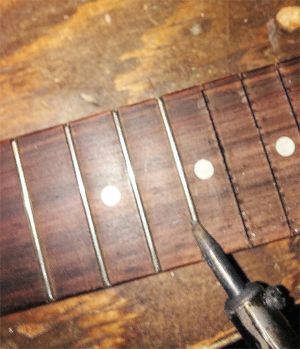
Heat one end of the fret for about a minute, then pull that end up a little bit with some needle-nose pliers:
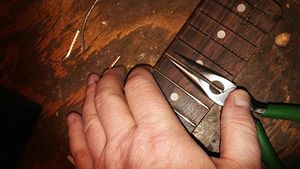
Then heat up the rest of the fret with the soldering iron, and gently but firmly pull out the rest of the fret.
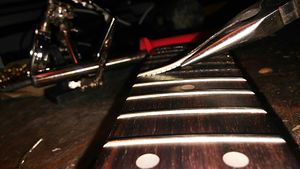
Remove the rest of the frets. Doesn't matter which fret you start with and which you end with. You can even jump around on the neck if that makes it more interesting. But it is physically tiring and mentally tedious. If you get burnt out, unplug your soldering iron and do something else, or nap, and resume later when you're bright eyed and bushy tailed. Don't do it in a hurry, you'll mess up the guitar or yourself.
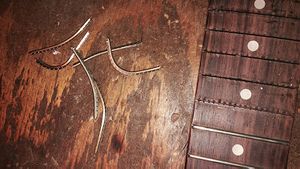
When all the frets are out, throw them away and lightly wet-sand the neck with fine sandpaper. Just use a few drops of water, and just sand a little bit....Only a touch to take off any burs produced by the fret removal, without grinding down the plane of the neck.
When done, let the neck dry for an hour or more.
Then use wood filler to fill in fret grooves, and any holes caused from pulling the hot frets. Push it in there with a wooden putty knife or a the dull side of a butter knife. Wipe off any excess.
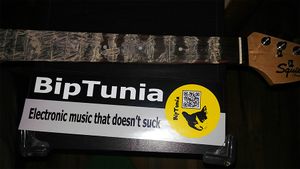
Let dry overnight, then sand with medium sand paper. Then wet-sand sand with fine sandpaper. Then wet-sand with fine sandpaper. Wipe with dry rag between each step.

Then screw the neck back on. While it's probably OK to use an electric drill bit screwdriver to remove the neck, I'd put it back on by hand, so you don't strip the threads. Do it the same way you took it off: Do one screw, then another, going all the way round until the neck goes back on evenly and tightly.
Any remaining ultra-light roughness will be taken care of over time by bending strings.
If you have ideas of staining the neck at this point, read your wood filler reviews on Amazon. Wood filler isn't as stainable as you'd think, even if it says it's stainable. And if you think you'll be good enough to play it accurately, especially microtonally, without seeing where the frets were, you must be an amazing musician.
These guys are pretty good on fretted guitars, but pretty much suck at their first try playing even 12 TET music on a fretless guitar.
Here's a guy blazing 12 TET on a fretless guitar, but he's a jazz cat, and the guitar has a metal neck, which gives more sustain. There are no fret markers on the neck, but there are on the side of the neck, facing him.
When you play a fretless guitar, to play a note you'd normally hear in 12 TET music, you have to put your finger exactly where the fret would be. It's much harder than playing fretted. Because fretted, you can put your finger almost anywhere between the two frets. Not far enough back so there is buzzing, but you have a LOT more leeway in finger position on the fretboard while still being in tune.
With a fretless instrument, your finger is the fret. This gets even more complicated with microtonal music. I recommend you first try playing your fretless guitar in 12 TET, playing along with a song you wrote, or know, and get to where you can play in tune. Then make a microtonal backing track with a VST and a MIDI keyboard, in a multiple or divisor of 12 edo. Like 6 edo. Or 24 edo. Play with that until it sounds good, then try it to a backing track of 7 edo. Or 5 edo. Or 13 edo.
Fretless tips:
So, put on NEW strings, plug into an amp, bend the strings until they stay in tune with a tuner, and start playing.
It's harder to get sustain on a fretless guitar. Because with frets, you have the string firmly terminated at both ends by hard metal; the bridge one end, and the fret at the top. Whereas fretless, you have metal at the bridge, but flesh at the other end. It's not as precise, and some of your finger will be dampening the string while it's terminating the length. So playing with less flesh on the fretboard is better than a sloppy "whole finger tip mashed on the fretboard" technique.
Thicker strings will give you more sustain, but will be harder to play. Some people put flat-wound strings on a fretless guitar, but then bending the string is pretty much out of the question. Especially if they're heavy flat-wound strings. Though on fretless, string bending isn't as needed, as you can just slide the note up a little while holding your finger down.
You can experiment with lowering the action (video tutorial here), that will make it easier to play and give you more sustain. But the strings will buzz if you go too low. And you'll lose intonation. Be sure to play all the way up and down the neck on all strings before you call this job done.
I'm still getting used to playing the fretless. You can hear my first microtonal fretless guitar track in this song, 'How to Survive a Nuclear Bomb', starting at 5 minutes and 45 seconds.
METHOD 5 - BUYING A MICROTONAL-FRETTED GUITAR OR GUITAR NECK
Tolgahan Çogulu makes his own microtonal nylon string acoustic guitars, but they're too expensive to produce for others yet. Though he's working on it.
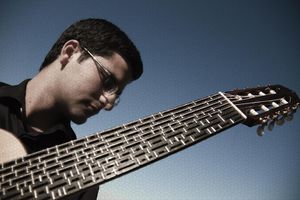
But if you play electric guitar, Ron Sword has a small company in in Florida, USA called Metatonal Music. There he makes and sells microtonal guitars. They're largely stock guitars with his microtonal frets added.
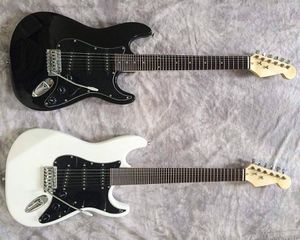
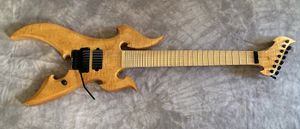
You can try making one yourself, but you better be damn good at math, and a good luthier to boot. Because it's not as easy as it sounds. Though if you do try it yourself, here's a site for calculating fret spacing for different scales. The site can import scala files too.
His wares work correctly tuned out of the box. Though once you play it a bit, you'll want to get some fret leveling work and general setup done by a good local guitar tech. Many music stores have one, or can recommend a good one. Use a good one. A lot of people claim to be able to do this work, but not everyone who claims can actually do it.
Ron also offers microtonal bolt-on necks, and also will re-fret your cherished guitar to convert it to microtonal.
Keep in mind, you'd need a different guitar (or neck) for each microtonal system. If you wanted to have 5000 microtonal tuning systems available to change at a whim like you can have with my free VSTs, you'd need 5000 guitars. Or at least 5000 necks, and a few roadies to quickly bolt them on and off, without stripping the threads.
But some people just love guitar more than keyboards, and there is something insanely cool about playing a microtonal guitar. It's somehow feels like you're traversing the past and the future at the same time.
Ron Sword does good, if quick 'n' dirty work to provide the electric guitars used by many microtonal bands that have guitars. The list includes Noah from Jock Tears, plus the wonderful Mercury Tree & Cryptic Ruse. (Mercury Tree & Cryptic Ruse are two separate groups, but they did some stellar collaborations that you can listen to here.)
Ron also has microtonal scale charts for his guitars on his site, to help you figure out what the heck to do with these things.
If you want to spend more money and get higher quality microtonal guitars, Eiichi Ishikawa in Vancouver, Canada makes good microtonal guitars. He's been making guitars (not just microtonal) longer than Ron's been alive. lol. Eiichi does work on Angus Young from AC-DC's (non-microtonal) guitars. Spencer Hargreaves from Jock Tears uses microtonal guitars from Eiichi Ishikawa, and loves them. Spencer has also played Ron's guitars and says they're great.
Keep in mind that you may want to buy a guitar from someone in your own country. Because you may be paying a lot of import duty if not. I bought some synthesizer parts from Belgium a while back, the USA (where I live) charged me 48% of the retail price to get my purchase!! That's on top of what I paid for the parts. The price on guitars may be similar. Though you could email a maker to ask about that, they'd likely know.
Jon Catler, in the USA, makes quality microtonal guitars. And and maybe have to wait to get them. Check out Jon Catler's work at Freenote.
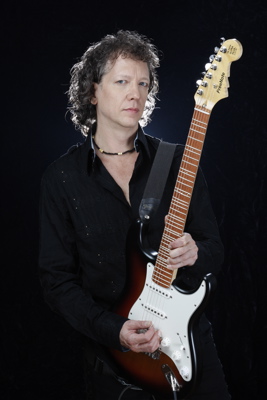
Jon also sells high-quality microtonal guitar necks, and great fretless guitars.
Brendan Byrnes has a Freenote 12-Tone Plus guitar from Jon Catler. (Brendan also has a 22 TET guitar and a 22-TET bass from Ron Sword.)
"12-Tone Plus lets you keep the standard 12 frets per octave in place while adding 12 new frets. These new frets are 7th, 11th, and 13th harmonics straight from the Harmonic Series. Pure harmony, shimmering dissonance, or anything in between, these notes will open new musical doors for any player in any genre."
Matthew Dolmage, in Canada, makes some gorgeous microtonal (and non-microtonal) guitars. Here is the Dolmage Designs Etsy, and here's his Facebook.
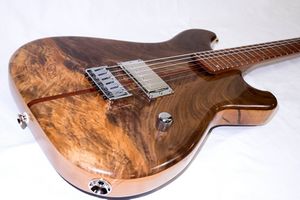
Ben Spees from Mercury Tree has a Dolmage Designs microtonal guitar neck, and loves it.
If you want the top of the line, have a bunch to spend, and don't mind waiting several months for something custom, amazing, and microtonal, talk to Dan Memory at Oni Guitars in Australia. Pix here. Contact info is here.
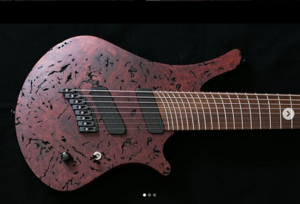
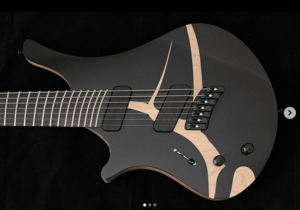

Eastwood Guitars makes microtonal models:
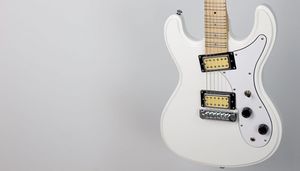
Starrett Guitars makes some real beauties too, and does custom microtonal work

FYI, There's a microtonal guitar thread on Reddit. And Neil Haverstick has some good articles and books on microtonal instruments in specific, and microtonal music in general:
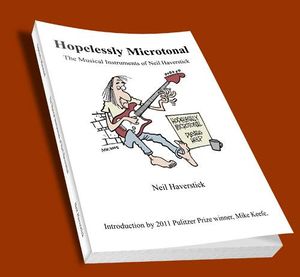
CLOSING ARGUMENTS
Microtonal music is a whole new world to fall into. It's relatively simple to dabble in it. And if you're good at 12 TET music, it doesn't take long to sound good in xen. But the wormholes you can fall down are incredibly deep and varied. It's a synthesis of art and deep math that is almost mystical to some people, far more so than ordinary everyday boring old 12 TET music.
Microtonal music is a great way to rocket yourself out of a rut, go to the next level, in parallel universes you didn't even know existed previously. It's a great path for musicians who have an insatiable thirst for the new, and for information. Plus it can sound darned good too.
You don't have to completely "go microtonal." Some microtonal musicians are exclusively microtonal, some almost to a macho "I'm different!" extent. But many of the better ones aren't exclusively microtonal, or consider themselves musicians first, and microtonal musicians a close second. I think that's a healthy and honest attitude.
Personally, the first 7 BipTunia records were 12 edo. VERY strange 12 edo, but 12 edo. The 8th BipTunia record was 90% microtonal. The one 6 after that and most going forth will likely be about 50% to 60% microtonal, and I think that's likely where I'll stay going forth.
I will make an informed guess that microtonal music is something that about 1 in 10,000 musicians who grew up in the west, or in a western tradition, do on a regular basis. At least the number is very likely somewhere in that magnitude. But xen is going to become more common, because it's good.
So it's a fine thing to get skilled at doing if you want to stand out.
RECOMMENDED MICROTONAL RESOURCES
Facebook group that's a continuation of an in-person group co-founded by Ivor Darreg in the 1970s. The pre-Internet iteration also functioned through the postal mail, sending cassette tapes back and forth (!)
The main reason there are any recordings of Ivor actually playing music himself at all is because Johnny Reinhard kept tapes that were personally given to him by Ivor, and Johnny recently started putting them online.
Ivor died a few months after the World Wide Web started, and before most people knew it existed. But Ivor was on a mission, and asked Johnny to share the music. So when the technology became ubiquitous, Ivor now lives again in the ears of people who weren't even alive when Ivor was playing gigs with his crazy homemade instruments.
The Xenharmonic Wiki Very in-depth educational resource from the Xenharmonic Alliance.
Microtonalitaly Facebook group
Good people, good info, good stuff.
Microtonal Music and Tuning Theory
Facebook group. Exactly what it sounds like. Posting detailed questions and discussions of xen theory and maths is far more welcome here than on the other groups. In fact, there some people on this group who are pure music theorists. And very good pure music theorists. That is, they don't actually make microtonal music (or any music), but know more about the hum of this universe than many musicians. But others in this group also make music.
Xenharmonic Musical Instrument Makers and Designers
Facebook group. Exactly what it sounds like. Mostly hardware, but it's not unwelcome to post or ask about software xen instrument making. I've done it.
American Festival of Microtonal Music
Long-running org for the furtherance of microtonal music.
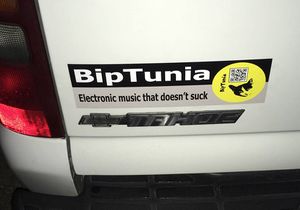
Want a free high-quality vinyl BipTunia 3" circle sticker? BipTunia is a cool music project that does a bunch of microtonal stuff. If you want to help spread the microtonal word send an email here. I'll send one of each to anyone who wants one, anywhere in the world, and then I'll delete the address you sent me.
LEGAL: VST is a trademark of Steinberg Media Technologies GmbH, registered in Europe and other countries. BipTunia Synths has been licensed for VST SDK use by Steinberg. Agreement countersigned by Steinberg on August 23, 2018.